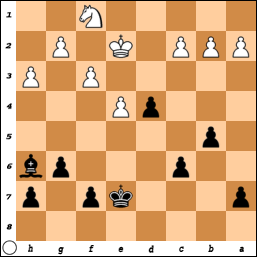 |
| Black has just captured on e5 in Spanton (2112) - M Soobik (2257), IECG (correspondence) 2005. Who stands better, and by how much? |
*****
*****
*****
*****
*****
*****
*****
*****
*****
*****
This ending is another arising from the Exchange Variation of the Spanish. White, as usual, has the better pawn-structure, although having all the white kingside pawns on light squares means the bishop has targets. In addition, most black pawns are on dark squares, which means they do not impede
the bishop, and the black king is centralised, while both white pieces are on the back rank.
The analysis engines Stockfish12 and Komodo11.01 reckon the position is equal.
Nevertheless this is one of those positions where, unless Black has an immediate win, it is only White who, thanks to the knight's flexibility compared with the bishop's monochrome character, can realistically hope to generate winning chances with normal play..
32.Ng2 Be8 33.Kd2 g6 34.h6!?
Safer is 34.hxg6, but I felt every exchange of pawns would bring a draw nearer, and after the text it is possible Black will have problems defending h7.
34...g5 35.c3 Bd7
Black is not able to directly go after the h6 pawn, eg 35...Ke6 36.Ne3 Kf7? fails to 37.Nd5 as 37...Kg6 38.Nxc7 Bc6 (or 38...Bf7) can be met by 39.Nd5.
36.Ke3 c5 37.Kf2 b5 38.Kg3 Be6
MS offered a draw.
If 38...Ke6, trying to go after the h6 pawn, the engines point out 39.a4!, when White is very much in business, eg 39...bxa4 40.Ne3 Bb5 41.f4, when Black is a pawn up but has four isolated pawns and massive problems holding his position together.
39.Ne3 Bf7 40.Nf5 Be8 41.Ng7 Bd7 42.Nf5 Be8
Not 42...Bxf5 43.gxf5, eg 43...a4 44.Kg4 b4 45.Kg3 Kd6 46.f4 gxf4+ 47.Kxf4 Ke7 48.e5 etc.
43.Ne7
The knight has got into Black's position, but the game is dead-equal, according to the engines.
Black now sets a little trap.
43...Bf7!? 44.Nc6+ Kd6
*****
*****
*****
*****
*****
45.Na7
Not 45.Nxa5? Kc7, after which the knight cannot escape.
45...Be8 46.Nc8+ Ke5 47.Nb6 Bf7 48.Nc8 Be8 49.a4!? b4!?
Also equal is 49...bxa4 as Black still cannot make a passer from his queenside pawn-majority. After the text, however, the a4 pawn remains a target for the bishop.
50.Nb6 Bf7!?
Setting another trap.
*****
*****
*****
*****
*****
51.Kf2
51.Nd7+ Ke6 (51...Kd6? 52.Nxf6) 52.Nxc5+? loses to 52...Kd6 as the knight falls, eg 53.Nb7+ Kc7 (53...Kc6?? 54.Nd8+) 54.Nxa5 bxc3 55.bxc3 Kb6 56.Nxc4+ Bxc4, when White has three pawns for the bishop but is completely lost.
51...Be6 52.Ke3 Kd6 53.f4 Kc6!?
53...Bxg4 54.Nxc4+ Kc7 (only move) 55.fxg5 fxg5 56.Nxa5 is better for White, according to Komodo11.01 at first, but the engine soon agrees with Stockfish12 that Black has more-or-less full compensation for being a pawn down.
53...gxf4+ 54.Kxf4 Ke7 is also equal, according to the engines.
54.f5
The drawish nature of the position can be gauged from the fact that 54.Nd5!? Bxd5 55.cxd5+ Kxd5 is still equal, according to the engines, despite Black having won a pawn.
54...Bf7
Not 54...Kxb6? 55.fxe6 Kc7 56.e5! fxe5 57.Ke4 Kd6 58.Kf5 etc.
55.Nc8
 |
| Position after 55.Nc8 |
*****
*****
*****
*****
*****
55...Kd7
55...Kc7?! seems to lose to an amazing line from the engines, viz 56.Ne7 Kd6 57.Ng6! Bg8 58.Kf3! Bf7 59.e5+! fxe5 60.Nf8 Bg8 61.f6! Bd5+ 62.Ke3 Bg8 63.f7! Bxf7 64.Nxh7, when Black is temporarily a pawn up but will lose thanks to White's passed h pawn. This line is not all forced, but appears convincing.
56.Na7 Kd6 57.Kf3 Bg8 58.Kf2 Bf7 59.Ke3
*****
*****
*****
*****
*****
59...bxc3?
59...Bg8 60.Nb5+ Ke5 (only move) 61.cxb4 cxb4 62.Nd4 Kd6 63.Nf3 Ke7 64.Kd4 Kd6 65.Nd2 c3! 66.bxc3 bxc3 67.Kxc3 Ke5! 68.Nc4+ Bxc4 69.Kxc4 Kxe4 70.Kc5! Kf4 71.Kd6 Kxg4 72.Ke6 Kh5 73.Kxf6 g4 74.Ke5 g3 75.f6 g2 76.f7 g1=Q 77.f8=Q is a long drawing line given by the engines. Even if there is a flaw in their analysis, Black has to go down this line as the text loses.
60.bxc3 Bg8 61.Nb5+ Ke5
So far, as in the drawing line given in the previous note, but the exchange on c3 means White has an extra, winning, option.
62.Na3 Bf7 63.Nb1 Kd6 64.Nd2 Bg8 65.Nf3 Ke7
Black has had to mark time while the knight redeploys ready for pushing the e pawn.
66.Ke2!
The immediate 66.e5 only draws after 66...Bd5 67.exf6+ (67.e6 Bc6 is also a draw) Kxf6 68.Nd2 Ke5.
66...Bf7
66...Kd6 loses to 67.e5+, eg 67...fxe5 68.Nxg5 Ke7 69.Ke3 Kd6 70.Ne4+ Kc6 71.Nf6 etc.
67.e5 Bxd5 68.exf6+ Kxf6 69.Nd2 Kf7
If 69...Ke5, we reach the same position as in the line with 66.e5, except that here White has the move 70.Ke3, after which Black is in zugzwang, eg 70...Bf7 71.Ne4 or 70...Kf6 71.Ne4+.
70.Ke3 Bc6 71.Ne4 Ba4 72.Nxg5+ Kg8 73.Kd2 Bc6 74.Kc1 Bd5 75.Kb2 Ba8 76.Ka3 Bc6 77.f6 Be8 78.Ne4 Bd7
78...Kf7 79.Nd6+ Kf8 80.Nxe8 Kxe8 81.g5, or 79...Kxf6 80.Nxe8+ Kg5 81.Ka4 Kh6 82.Nf6 Kg5 83.Nxh7+.
79.g5 1-0
Material is level in the final position, but Black is lost. The engines' main line runs 79...Bf5 80.Nd6+ Bc2 81.Nxc4, when one plausible continuation runs 81...Kf7 82.Kb2 Bd1 83.Nd6+ Kg8 84.f7+ Kf8 85.g6 etc.

















